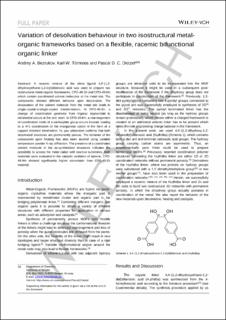| dc.contributor.author | Bezrukov, Andrey | |
| dc.contributor.author | Törnroos, Karl Wilhelm | |
| dc.contributor.author | Dietzel, Pascal D.C. | |
| dc.date.accessioned | 2024-03-05T08:08:32Z | |
| dc.date.available | 2024-03-05T08:08:32Z | |
| dc.date.created | 2016-09-27T12:15:55Z | |
| dc.date.issued | 2016 | |
| dc.identifier.issn | 1434-1948 | |
| dc.identifier.uri | https://hdl.handle.net/11250/3120999 | |
| dc.description.abstract | A racemic mixture of the chiral ligand 4,4′-(1,2-dihydroxyethane-1,2-diyl)dibenzoic acid was used to prepare two isostructural metal–organic frameworks, CPO-49-Zn and CPO-49-Mn, which contain coordinated solvent molecules at the metal site. The compounds showed different behavior upon desolvation. The dissociation of the solvent molecule from the metal site leads to a single-crystal-to-single-crystal transformation. In CPO-49-Zn, a change of coordination geometry from trigonal bipyramidal to tetrahedral occurs at the zinc atom. In CPO-49-Mn, a rearrangement of coordination mode of a carboxylate group occurs instead, leading to a 4+1 coordination of the manganese cation in the form of a capped distorted tetrahedron. N2 gas adsorption confirms that both desolvated structures are permanently porous. The behavior of the compounds upon heating has also been studied using variable temperature powder X-ray diffraction. The presence of a coordinated solvent molecule in the as-synthesized structures indicates the possibility to access the metal cation with reactive substrates. Both materials were evaluated in the catalytic oxidation of styrene. CPO-49-Mn showed significantly higher conversion than the CPO-49-Zn material. | en_US |
| dc.language.iso | eng | en_US |
| dc.publisher | Wiley | en_US |
| dc.relation.uri | http://dx.doi.org/10.1002/ejic.201600681 | |
| dc.title | Variation of desolvation behavior in two isostructural metal–organic frameworks based on a flexible, racemic bifunctional organic linker | en_US |
| dc.type | Journal article | en_US |
| dc.type | Peer reviewed | en_US |
| dc.description.version | acceptedVersion | en_US |
| dc.rights.holder | Copyright 2016 Wiley-VCH | en_US |
| cristin.ispublished | true | |
| cristin.fulltext | postprint | |
| cristin.qualitycode | 1 | |
| dc.identifier.doi | 10.1002/ejic.201600681 | |
| dc.identifier.cristin | 1386277 | |
| dc.source.journal | European Journal of Inorganic Chemistry (EurJIC) | en_US |
| dc.source.pagenumber | 4430-4439 | en_US |
| dc.relation.project | Norges forskningsråd: 209339 | en_US |
| dc.relation.project | Norges forskningsråd: 247734 | en_US |
| dc.relation.project | Norges forskningsråd: 227702 | en_US |
| dc.identifier.citation | European Journal of Inorganic Chemistry (EurJIC). 2016, 2016 (27), 4430-4439. | en_US |
| dc.source.volume | 2016 | en_US |
| dc.source.issue | 27 | en_US |
